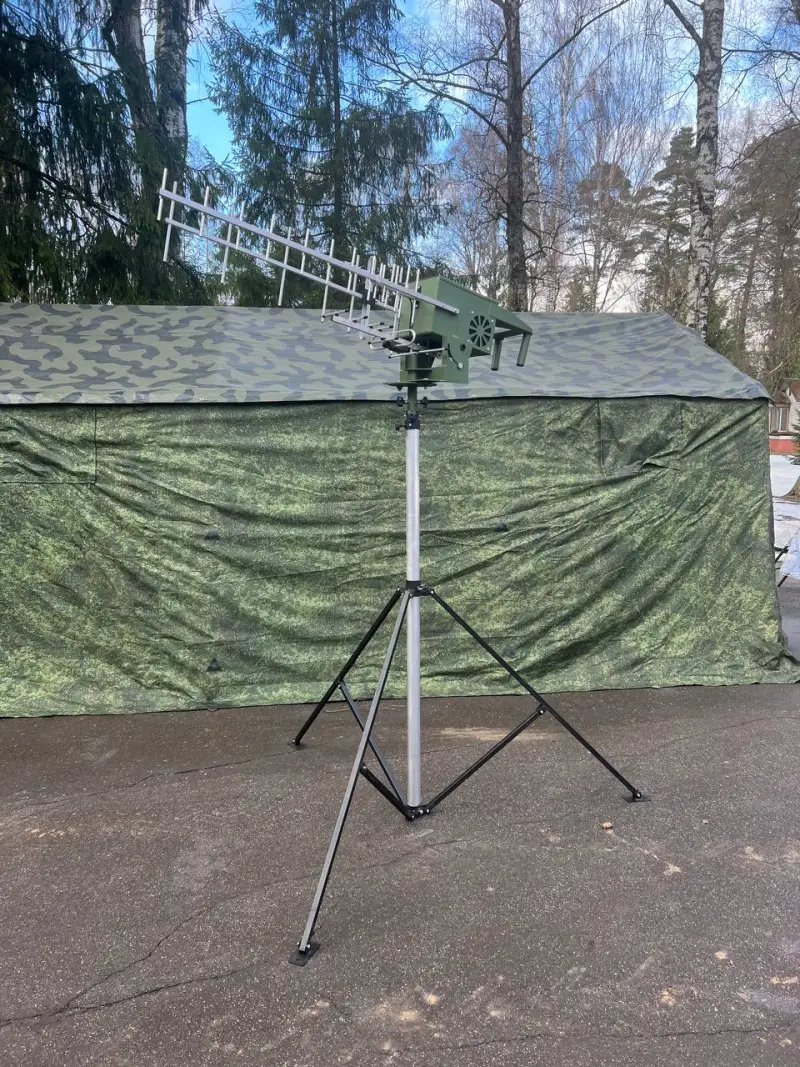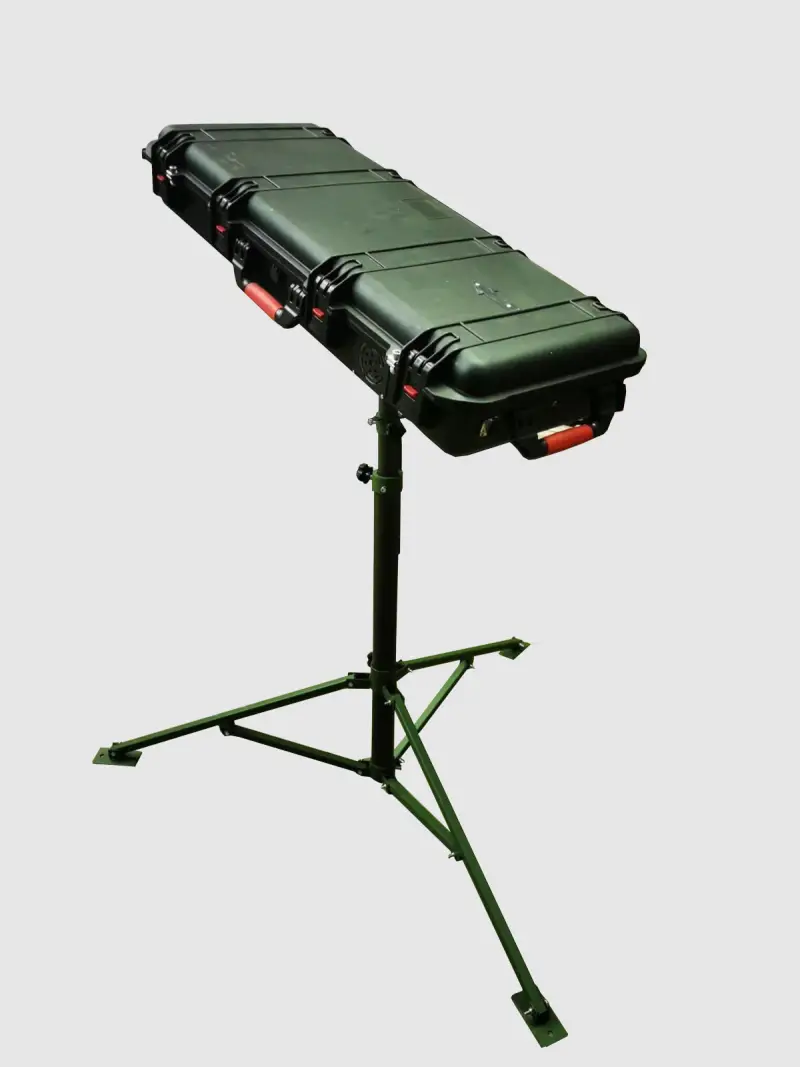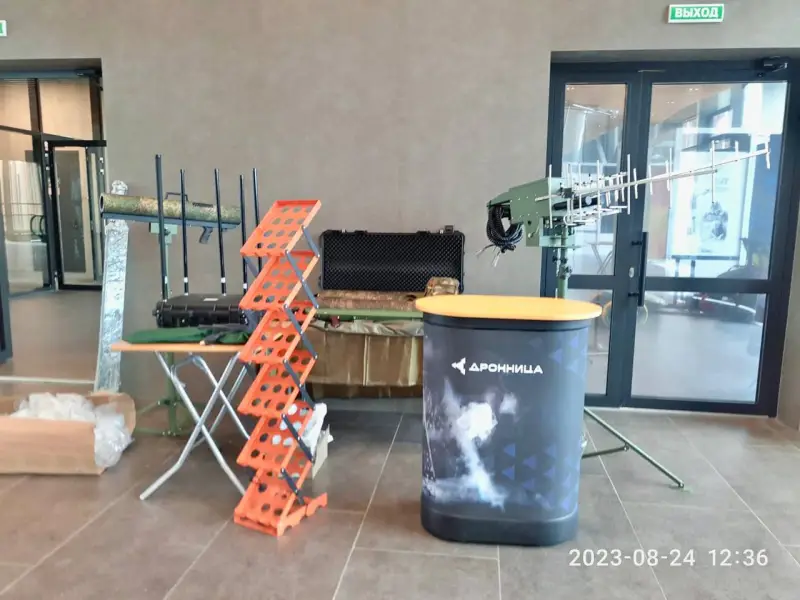Electronic warfare complex "Argus-Antifuria" is preparing for series

"Argus-Antifuria" of the first version in working position
Now our country produces many electronic warfare systems designed to counter unmanned aviation, and new designs or updated versions of already known products appear regularly. In particular, NPO Kaysant previously presented the Argus-Antifuria electronic warfare station, and is now preparing its modernized version for production. Its release is planned to begin in the near future.
Promising station
The Moscow NPO Kaysant became involved in the topic of electronic warfare and countering UAVs only last year, but has now managed to develop and present a number of different types of samples. Thus, in March they showed for the first time the Argus-Antifuria mobile radio channel suppression system, designed for long-term protection of specified areas from large drones.
Soon after this, the station went to Donetsk to conduct tests near the combat zone. Exactly what tasks Argus-Antifuria had to solve, for what purposes the station worked, etc., was not reported. Apparently, the tests were successful, and the development organization began to demonstrate the station at specialized exhibitions and look for opportunities to obtain a government contract.
In mid-October, it was announced that the experience of recent tests is now being used to develop an upgraded version of the station. In particular, it will receive its own direction finder for air targets and radio channels. During previous tests under different conditions, the detection of air targets and radio channels was carried out using third-party systems and tools. This approach helped solve problems, but was not convenient and imposed some limitations.

Transport case
Modernization project
On December 11, the RT news agency published an interview with Alena Balandina, development director of the NPO Kaysant. During the conversation, interesting facts were heard about the current work of the Kaysant NGO, incl. about the development of existing projects, such as Argus-Antifury, and plans for the future.
It is reported that the mobile station is being used at the front, and positive feedback is being received from operators. At the same time, fighters talk about the need to increase the range. Now the development company is awaiting a test report - this document will allow us to draw conclusions about the real potential of the complex and make plans for the future.
A. Balandina revealed some details of the Argus-Antifury modernization project. According to her, this process was not limited only to the introduction of a direction finder. The internal and external units of the system have undergone restructuring, and now we are talking about almost a completely new product. At the same time, work continues on the integration of the direction finder, and the main attention is paid to eliminating the negative mutual influence of the system instruments.
The current work is planned to be completed in the very near future, after which production should begin. The series is going to launch early next year, but a more precise date has not yet been announced. The scale of future production is also not mentioned.

NPO Kaysant has not yet received orders from the Ministry of Defense, but the necessary agreements have already been reached. To be accepted into service, new systems must undergo the necessary tests in different conditions and using different training purposes. At the same time, the Ministry of Defense cooperates with large and small organizations and shows interest in new developments.
Technical features
The Argus-Antifuria product is a stationary/mobile directional jamming station with the function of suppressing radio channels used by UAVs. There are already two versions of such a station with similar architecture and identical functions, but with serious differences in design and differing operating capabilities.
The Argus-Antifury kit includes the station itself with a hard case for transportation, a telescopic tripod machine, power supplies, etc. The complex can be deployed in a stationary position or mounted on a vehicle. The principles of its operation do not change. The design of the tripod and station provides almost circular horizontal guidance and vertical guidance within a sector 145° wide.
The station itself is designed as a single unit with the necessary equipment. It has a complex-shaped case, inside which the electronics and cooling system are placed during operation. A set of directional antennas is mounted on the front wall of the housing. The body is equipped with handles and buttons, with the help of which the station is aimed at the target and interference is turned on. Automation of work is not yet envisaged.

"Argus-Antifuria" can interfere in seven different ranges - from 443 to 5800 MHz. In fact, all major bands used by popular UAVs to transmit commands, telemetry and video are suppressed. The frequencies of signals from the main satellite navigation systems are also processed. The power of the generated interference is 10-20 W, regardless of the frequency. The range is at least 2-3 km, depending on the characteristics of the target.
The modernized version of the station includes a direction finder. Information about this device and how to integrate it is not yet available. It is clear that it must track radio signals characteristic of drones, as well as determine the direction to their source.
Several power supply options are available. The station includes a rechargeable battery that provides operation for some time. For longer operation, it is possible to use a generator, connect to a household network or to the on-board network of cars. Power consumption – no less than 420 W.
The principles of use and operation of Argus-Antifury, both in the basic and modernized versions, are quite simple. The operator monitors the air situation using standard or third-party means and waits for the enemy UAV to appear. When it is detected, the station manually aims at the target and jams. Depending on the selected operating mode, the target drone loses the ability to navigate or execute commands, and also stops performing its task.

One of many
The basic version of the Argus-Antifuria electronic warfare system was tested in Donetsk in the spring and summer and demonstrated its capabilities on real enemy UAVs. As a result of these activities, the product was finalized, and its improved version is now undergoing final checks and is being prepared for mass production. Also, NPO Kaysant interacts with the Ministry of Defense in order to receive orders and supply new equipment to the troops.
It should be noted that the Argus-Antifury system is far from the only one of its kind. Currently, more than a dozen domestic organizations are engaged in the development and production of UAV suppression systems - this number includes both recognized leaders in their industries and small organizations. In total, dozens of different systems and designs have been developed and offered.
For example, NPO Kaysant, together with the Argus-Antifuria product, produces a number of other portable and stationary means of countering unmanned aircraft. They also find use in combat zones, undergo testing, etc. At the same time, the development of new models and modernization of existing ones does not stop.
All these processes will continue in the future. In an interview with RT, A. Balandina noted that the designs and technologies of anti-UAV systems become obsolete in just three months. Therefore, constant refinement is required, updating operating frequencies, etc. The next result of such work in the near future will be serial products “Argus-Antifury” of an updated version.
Thus, the most important area receives the necessary attention and is actively developing. The appearance of new or upgraded samples is regularly reported, and a large number of such products are sent to the Special Operation zone. NPO Kaysant is trying to participate in these processes, and we can expect that new information about the results of its work will appear in the foreseeable future.
Information